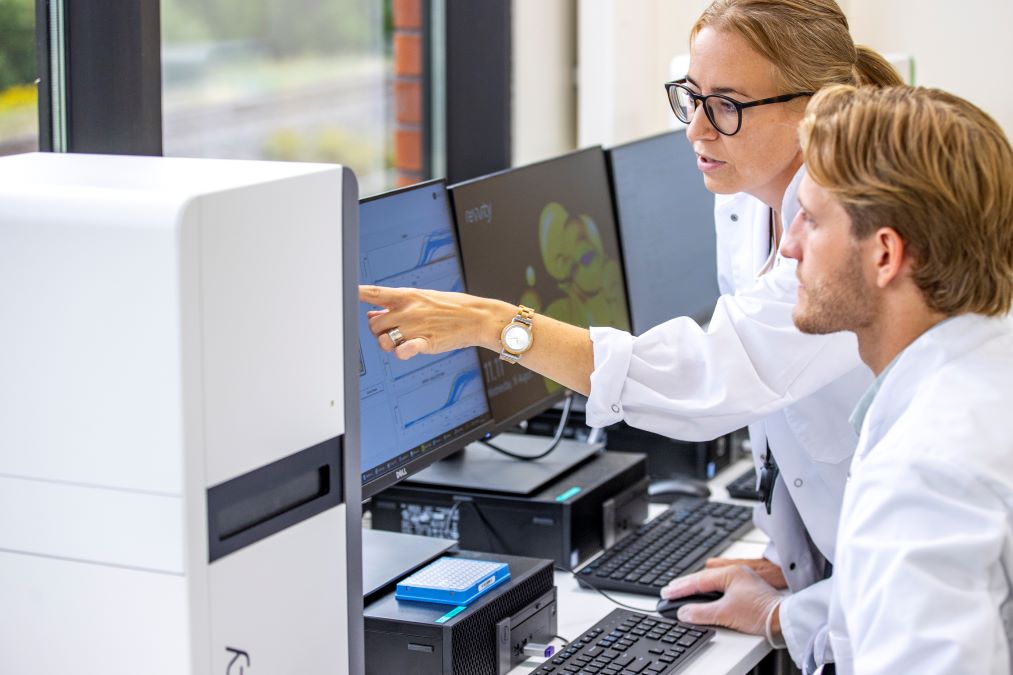EONIS Q – Empowering Laboratories
Molecular Testing in Newborn Screening for SCID & SMA.
Transforming molecular workflow efficiency and accessibility for laboratories of all sizes
Introduction:
Newborn screening plays a crucial role in detecting and preventing potential health issues in infants, ensuring early intervention, and improving long term outcomes.1. Newborn screening centres often strive to optimise their processes relating to reducing complexity, making sure they can be more time efficient whilst ensuring infrastructure (space) meets the requirements of any modern-day laboratory.
An initiative to screen for SCID (severe combined immunodeficiency) & SMA (spinal muscular atrophy) is gathering huge pace across the globe, yet challenges exist in overlaying new solutions into very busy, crowded newborn screening labs.
The advent of new product innovation has brought forth promising solutions that can revolutionise these centres, streamlining operations, and enhancing efficiency.
——————————————————————————————————————————————
In this blog post we will explore how innovation that can be found in the EONIS™ Q workflow can transform newborn screening centres who want to screen for SCID and SMA, ultimately benefiting the health and well-being of newborns. There are 3 key areas that can bring about this transformation…
Streamlined Processes for Rapid Results
One of the significant advancements in newborn screening technology is the integration of automated systems. Traditional Molecular automated screening procedures using wet qPCR can involve several steps and sample processing which can (in some cases) be time consuming and may risk some level of errors in the steps taken. EONIS Q changes this dynamic and supports an approximate 3-hour turnaround enabling less handling of samples and reagents, reducing the complexity associated with manual processes. By multiplexing, EONIS Q can analyze several analytes simultaneously accelerating the screening process and delivering rapid results. Less hands-on steps minimize errors related to human intervention, which ensures accurate diagnoses supporting the timely intervention in the fight to combat SCID and SMA for newborns.
Compact Equipment for Space Optimisation
Newborn screening centres across many geographies are often limited by space constraints, leading to challenges in accommodating the necessary equipment and resources. With many newborn screening labs also pushing to include SCID and SMA screening to their current services, there is a risk that significant infrastructure changes are necessary, this is not always possible and of course has economic consequences that come into play. The EONIS Q assay contains just 3 steps.
First – you punch samples. Second – run a simple DNA elution protocol with no wash steps. Thirdly run PCR, using the PCR plates that contain the dried PCR reagents, and analyze the results with an NBS-customized software. It’s as simple as that!
Another valuable element of EONIS Q is that no clean pre-PCR area is needed, and it’s all contained in a very small Instrument footprint!
All these workflow steps can be completed in less than 3 hours, meaning that with one instrument you can run more than 200 samples/day, but with 6 instruments together you can run more than 1500 samples/day. Furthermore, if you continued to multiply the number of instruments, you could easily facilitate even higher volumes of samples so the assay can suit both small labs whilst providing an option for scaling slightly larger labs delivering increased daily samples.
Integrated, Intuitive Data Management Systems
Efficient management and interpretation of screening data are crucial for effective SCID and SMA newborn screening. Traditional paper-based record keeping systems can be cumbersome and prone to errors, hindering the overall process. The EONIS Q software system (EASI) has been designed to be easy, intuitive, and simple to use, so much so – anyone new to PCR software could use it. There is no need to understand amplification curves and interpret them – the system offers a fast and reliable result without requiring those skillsets.
New cybersecure software product innovations provide integrated data management systems that streamline information flow, enabling real-time data capture analysis and storage. The EASI (dedicated to newborn screening) software system can also support and facilitate seamless communication among healthcare professionals, allowing for collaborative decision making and quick interventions. In addition, cybersecure, cloud based integrated data management from EONIS Q ensures accurate tracking of newborns throughout the SCID and SMA screening process providing a comprehensive overview of their health status and reducing the chances of missed diagnoses.
In Conclusion
The Integration of the EONIS Q platform into newborn screening centres that want to start screening for SCID and SMA – (either as a small lab starting up or an existing lab with a view to increasing throughput) has the immense potential to transform the way labs orientate their services, resources, infrastructure, and finances. By reducing complexity, saving time, and optimising space the innovation that EONIS Q brings to the fore collectively contributes to the potential for improved patient outcomes, and enables healthcare providers to offer a solution to underserved populations.
As we look to embrace the innovation and solutions that exist with EONIS Q – we should ask ourselves the question; Can we unite in creating a future for SCID and SMA newborn screening centres that can deliver comprehensive care to ALL infants, no matter the specification of the lab, ensuring a healthier start for all newborns globally?
The EONIS Q system and workflow – now changes the status quo. Newborn screening using qPCR is now accessible for all labs… and that must be a good thing.
References
- RBradford L.Therrell, Carmencita David Padilla J. GerardLoeber Issam Kneisser Amal Saadallah Gustavo J.C.Borrajo John Adams – Current status of newborn screening worldwide: 2015 Seminars in Perinatology Volume 39, Issue 3, April 2015, Pages 171-187.
Products may not be licensed in accordance with the laws in all countries, such as the United States and Canada. Please check with your local representative for availability
